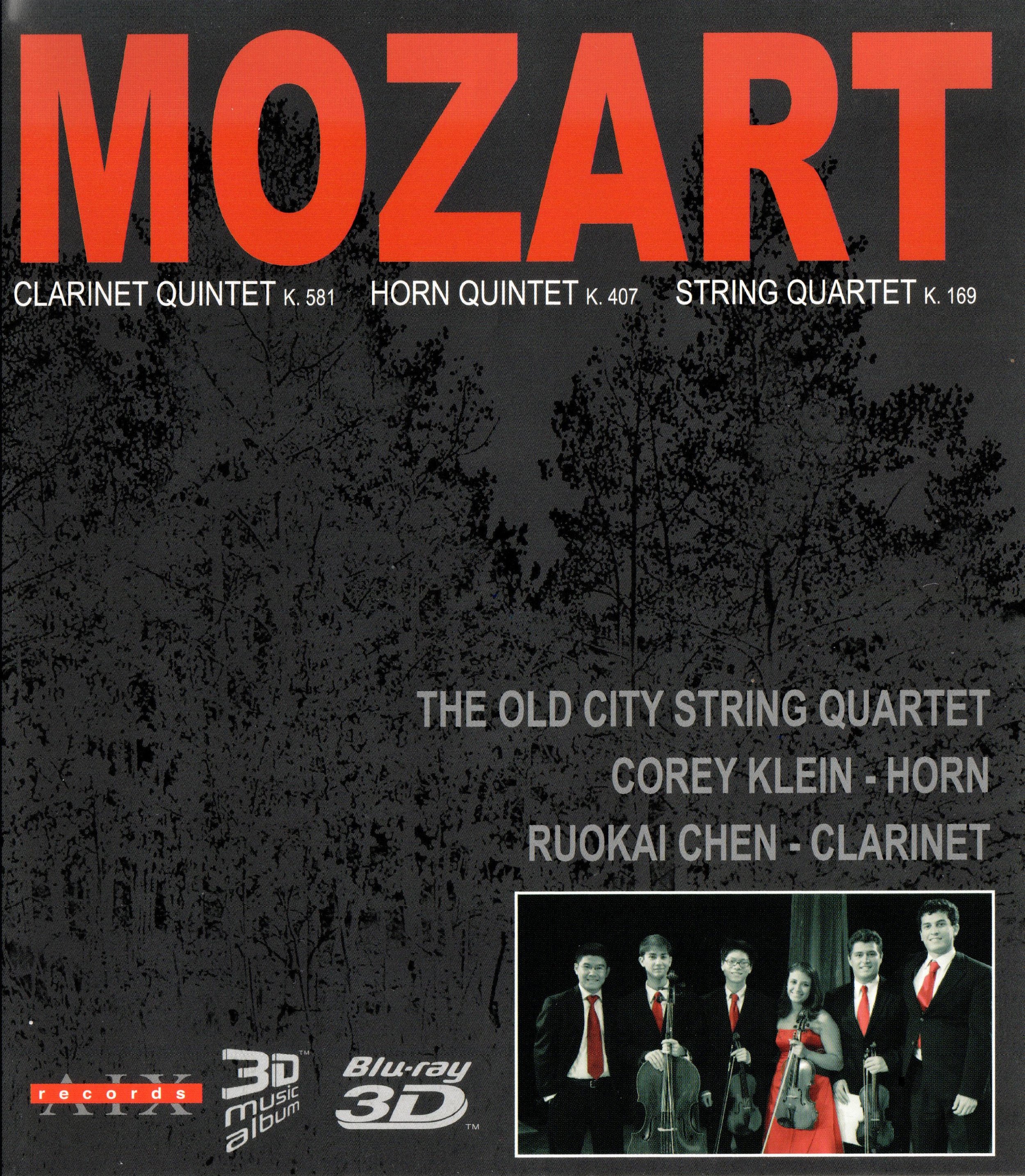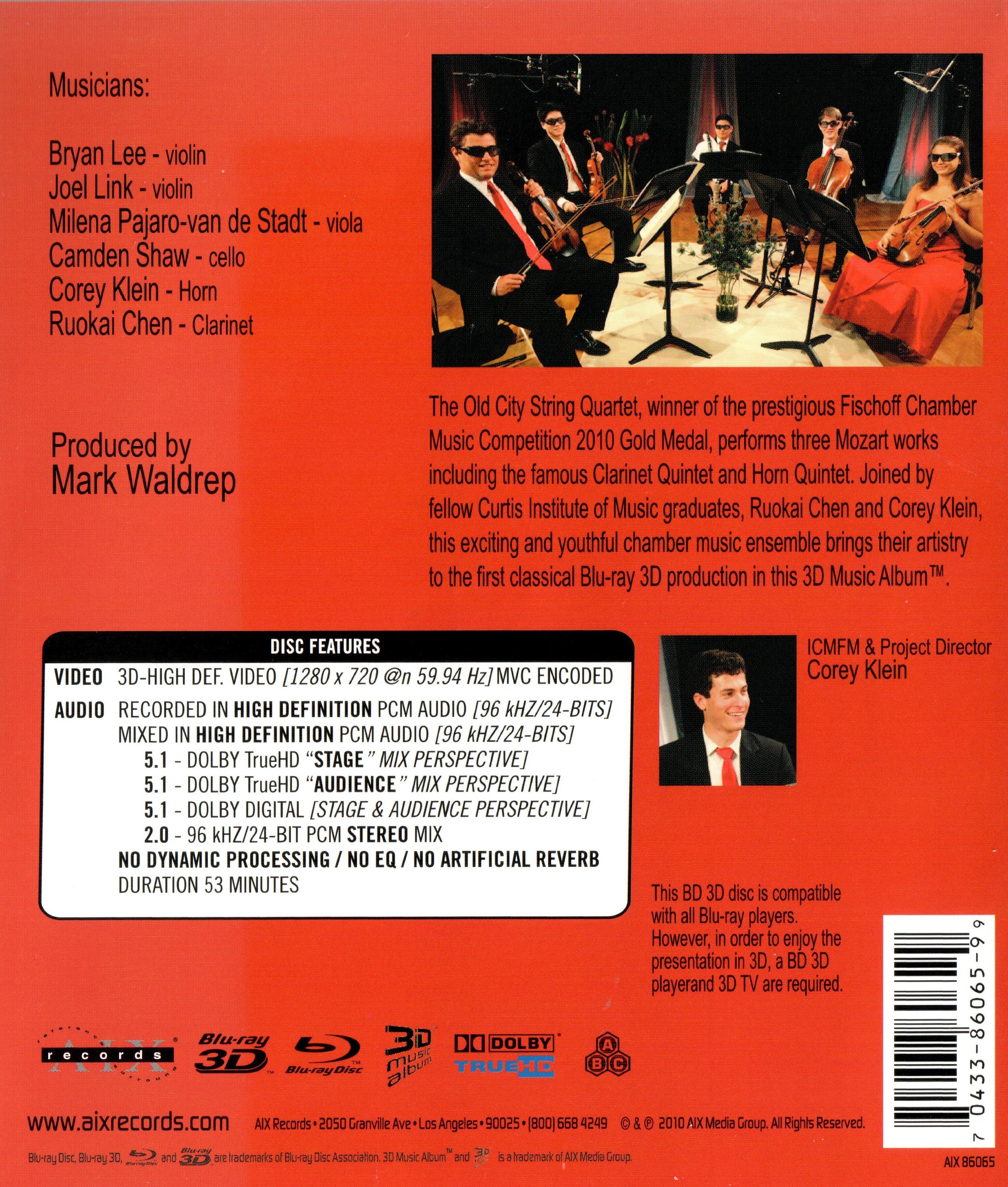

Mozart Chamber Music. Performed by The Old City String Quartet: Bryan Lee, violin; Joel Link, violin; Milena Pajaro-van de Stadt, viola; and Camden Shaw, cello. (The name of the group was later changed to the Dover Quartet.) Special appearances by Corey Klein on horn and Ruokai Chen on clarinet.
Here's the program:
Clarinet Quintet in A Major, K. 581
String Quartet, K. 169
Horn Quintet in E-flat Major, K. 407
Directed and produced by Mark Waldrep. Presented in 2D and 3D, but the menu doesn't give you a choice of dimensions. If your set up is just 2D, it plays as usual. If you have a 3D set up, you get 3D. If you have a 3D set up but want to see the 2D presentation, you start with 3D, and then switch to 2D as permitted by your gear. (Another way would be to enter the menu, go to video set up, and turn off 3D.) We will review this as a 2D disc that everyone can enjoy.
This title has 53 minutes of music. The audio was recorded with 96 kHz/24-bit sampling, mixed in a 5.1 Dolby TrueHD "Stage" mix, a 5.1 Dolby TrueHD "Audience" mix, and a 5.1 Dolby Digital mix (as well as stereo). Grade: A+ for 2D only.
First lets discuss the 2D presentation. AIX is famous for super-audiophile sound recordings. They were also interested in video. AIX first made DVDs. But they soon pushed into high-definition video in both 2D and 3D. AIX prefers to record in laboratory-type venues with no live audiences. They tend to record lesser-known or local artists. So in the past we have tended to consider the AIX titles as "demo" records.
But AIX turned a corner with this Mozart chamber music record in its 2D presentation. The Dover Quartet is not a household name. But it is also definitely not a local group; they play regularly in serious venues all over the U.S. All the musicians in the quartet seem still to be in their twenties; with maturity, they have a shot at becoming a household name nationally or even internationally (well, at least in musical households).
Our first screenshot shows, from left to right, Joel Link on violin, Bryan Lee on violin, Ruokai Chen on clarinet, Camden Shaw on cello, and Milena Pajaro-van de Stadt on viola playing the the Clarinet Quintet, K. 581:
A nice portrait of Ruokai:
Closer views of Camden and Milena:
Here's the quartet alone in the String Quartet K. 169. Now Bryan is on 1st violin (I think):
And here's the configuration for the Horn Quintet K. 407. This is scored for 1 violin and 2 violas. Bryan has put aside his violin and is playing the 2nd viola part (I think):
The best shot I could get of Corey Klein on the horn:
And here's another angle on Corey, which also shows the two violas well:
The screenshots show that the video is pretty. The video specs are unusual: 1280 x 720 at 59.94 Hz (2 x the normal 29.97 spec). The lighting is decent, but you still sometimes see shadows on the faces of the players (from all those microphones all over the place).
Mark Waldrep of AIX is primarily interested in the best recording of music that current technology can achieve. I'm not an audiophile. But I am qualified to say that this title has the best music recording that has been published so far in a HDVD (August 2018). The sound of each instrument is almost unbelievable real. And when the instruments are played in various combinations, you often can hear each instrument individually contributing to the harmonious whole. And since I believe that seeing the performance is an important component to full perception of music, I'll say this is arguably the best 53 minutes of string chamber music ever published.
The quality of the performance takes this title out of the demo category. With this record, AIX and the Dover Quartet are competing in the international market for classical music recordings. So if you are interested in chamber music, you would want to add this to your HDVD library.
Now having said all these nice things, I still doubt that this has been a red-hot seller. 53 minutes of music (on a Blu-ray that can hold 4 times as much material) is not impressive. Selling music in one-hour chunks was what you did with LPs, and that was long, long ago. Today (2018) we have HDVDs with three-hour+ operas or all the Beethoven piano concertos played by Daniel Barenboim on a single disc.
Now to 3D. Since this was written, 3D has pretty much disappeared from the market and I no longer have a 3D display. But I want to keep the following observations just for the record:
"Now lets go to the 3D version. Is seeing this in 3D worth all the trouble? Start with those fragile 3D glasses (no kids please) that have to be cleaned with special cloth and have their own batteries to keep up with. Once the glasses are on and the set up is playing 3D, you notice something like a 20% reduction in light coming from the picture. Even with my display mode set at "Brilliant," the dinginess of the AIX picture in 3D is quite noticeable. In 2D the musicians looked "warm"; in 3D, they look sunburned. The reduction in light output in 3D comes from the fact that the glasses have a tint in the lenses that's required by the 3D technology. Another disadvantage from the tinted lenses is that I can't see the remote controls well enough to use them with the glasses on. The resolution of the picture seems degraded from the slightly soft look in 2D. It seems there is often a kind of "lag" in the clarity of the picture when the scene changes. I too often get the impression from this title that the people you see in the picture are really photos pasted on cardboard set up in the room—i.e. this rendering of 3D is different from the seamless and ubiquitous 3D images we all take for granted in everyday life. Finally, this 3D image is sometimes spoiled by objects (like a music stand) that suddenly appear to be in my HT room where they don't belong.
The only advantage I get from this 3D picture is I can see better where the players are situated in respect to each other. To me, this is a tiny advantage. None of them are attacking me. Nor am I trying to lasso anyone in the quartet to serve to my tribe for dinner. There are plenty of clues for me in 2D about their locations. None of the musicians are moving around in a way that I might better understand with 3D capability. Finally, one could say that the 3D view makes the image more "real." Oh, really? I know what see in my HT is not real. I'm not seeking reality. All I want is sounds and images that gives me a chance, with a minimum of distractions, to appreciate what the reality was on recording day.
So I conclude that the advantages of 3D for a string quartet are distinctly outweighed by the disadvantages. Subject title came out in 2012. Since then, I get the impression that 3D in the field of classical music is dead with current technology. Still, kudos to Mark Waldrep for his tenaciousness in working hard for a year to get the 3D version on this disc.
Summary: if you are interested in video of classical chamber music, you should consider his title for the 2D version alone. It gets an A+ for a glowing performance by beautiful young musicians who may well sound better in your home theater than anything else you have.
To buy this title, try clicking here.









